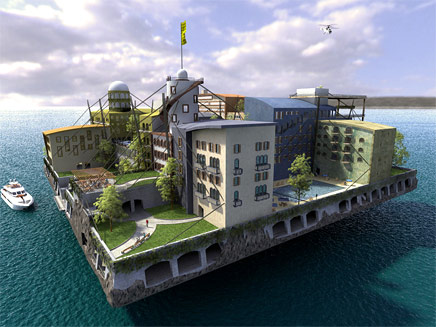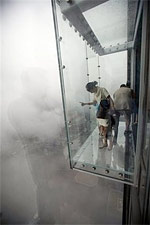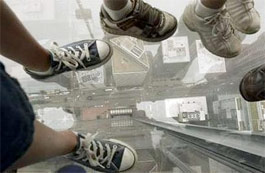Thursday, July 02. 2009
First look: AA summer pavilion

This year’s Architectural Association (AA) summer pavilion in Bedford Square, London, is unveiled tomorrow (3 July).
The competition-winning installation, Driftwood, comprises 28 layers of plywood and was conceived by 3rd year AA student Danecia Sibingo.
The sculpture was fabricated at Hooke Park, the AA’s 350-acre campus and workshop in West Dorset where the 2006 winning Fractal pavilion is permanently installed.
Sibingo was helped by a team that includes Lyn Hayek, Yoojin Kim, and Taeyoung Lee on the pavilion which was, according to the school, takes its inspiration from the sea.
See pages 41-45 of this week’s Architects Journal for reviews of this year’s student exhibitions.
-----
Personal comment:
Intéressant de voir revenir la mode du "pavillon" comme petit objet architectural de "statement" (Serpentine, AA School, etc.)
Bel objet ici ceci dit. Ni plus, ni moins.
Seasteading Competition Winner

The Seasteading Institute is an organisation dedicated toward creating sustainable sea platforms where people can choose to live if they�re unsatisfied with life on solid ground. They recently held a design contest for people to come up with new deep-sea micronations like Sealand, and the winner has been announced. Sealand News
-----
Via Archinect
Personal comment:
Construire des territoires physiques pour les micronations, l'idée n'est pas inintéressantes, d'autant plus ici si cela apparaît comme une forme de contestation.
par contre, au niveau de l'architecture... Mélange entre Fort Boyard, Hundertwasser et des "îles" sur Second Life (le côté très Second Life de ce projet est assez étonnat d'ailleurs!) un peu dans un style "vernaculaire-technologique".
Acrophobia @ 1353 ft.


Sears Tower unveils glass balconies. Acrophobia and vertigo included. Lets look.
-----
Via Archinect
Interactions interview
The following “interview” with me appears in the July/August 2009 issue of Interactions magazine, the ACM’s journal on interaction design. I say “interview” because it’s basically an edit on the sprawling chat Tish Shute had with me for her site, back in February of this year; as we know, even minor editorial alterations can produce disproportionate shifts in tone and emphasis, and that’s certainly the case here.
I should say from the outset that I don’t have much use for the ACM, and in particular greatly dislike their stance on access to publications, which flies in the face of my own conviction that the point (and power) of knowledge is to share it. Accordingly, I’m republishing the piece in its entirety here. For the sake of accuracy, I’ve left the editorial characterization of me and my work intact, but you should never, ever construe this as an endorsement of same. As ever, I hope you enjoy it.
“At the end of the world, plant a tree”
Six questions for Adam Greenfield
Adam Greenfield is Nokia’s head of design direction for service and user-interface design, and the author of Everyware: The dawning age of ubiquitous computing and the upcoming The City Is Here For You To Use. He is also an impactful speaker and articulate blogger, and has become a major authority in the thinking about the impact of future ubiquitous technologies on people and society.Interactions Magazine.
In a lengthy interview with Tish Shute recently published on UgoTrade.com, Greenfield ranged over topics including augmented reality, Usman Haque’s Pachube project, the networked book, the networked city, and what to do at the end of the world.
The interview is dense and rich, with many of the questions raised relevant to our audience. We asked Adam to expand on some of his answers for
TS: The legal scholar Eben Moglen has identified three elements of privacy: anonymity, secrecy and most importantly autonomy. How do you see Moglen’s three elements being worked out in a ubiquitously networked world? Are there ways we could design ubiquitous systems that might support personal autonomy?
AG: If we accept for the moment a definition of autonomy as a feeling of being master of one’s own fate, then absolutely yes. One thing I talk about a good deal is using ambient situational awareness to lower decision costs – that is, to lower the information costs associated with arriving at a choice presented to you, and at the same time mitigate the opportunity costs of having committed yourself to a course of action. When given some kind of real-time overview of all of the options available to you in a given time, place and context – and especially if that comes wrapped up in some kind of visualization that makes anomaly detection a matter of instantaneous gestalt, to be grasped in a single glance – your personal autonomy is tremendously enhanced. Tremendously enhanced.
What do I mean by that? It’s really simple: you don’t head out to the bus stop until your phone tells you a bus is a minute away, and you don’t walk down the street where more than some threshold number of muggings happen – in fact, by default it doesn’t even show up on your maps – and you don’t eat at the restaurant whose forty-eight recent health code violations cause its name to flash red in your address book. And all these decisions are made possible because networked informatics have effectively rendered the obscure and the hidden transparent to inquiry. And there’s no doubt in my mind that life is thusly made just that little bit better.
But there’s a cost – there’s always a cost. Serendipity, solitude, anonymity, most of what we now recognize as the makings of urban savoir faire: it all goes by the wayside. And yes, we’re richer and safer and maybe even happier with the advent of the services and systems I’m so interested in, but by the same token we’re that much poorer for the loss of these intangibles. It’s a complicated trade-off, and I believe in most places it’s one we’re making without really examining what’s at stake.
So as to how this local autonomy could be deployed in Moglen’s more general terms, I don’t know, and I’m not sure anyone does. Because he’s absolutely right: Bernard Stiegler reminds us that the network constitutes a global mnemotechnics, a persistent memory store for planet Earth, and yet we’ve structured our systems of jurisprudence and our life practices and even our psyches around the idea that information about us eventually expires and leaves the world. Its failure to do so in the context of Facebook and Flickr and Twitter is clearly one of the ways in which the elaboration of our digital selves constrains our real-world behavior. Let just one picture of you grabbing a cardboard cutout’s breast or taking a bong hit leak onto the network, and see how the career options available to you shift in response.
This is what’s behind Anne Galloway’s calls for a “forgetting machine.” An everyware that did that – that massively spoofed our traces in the world, that threw up enormous clouds of winnow and chaff to give us plausible deniability about our whereabouts and so on – might give us a fighting chance.
TS: Early theorizing of a “calm,” “invisible” ubicomp seems out of synch with the present-day reality of services like Twitter and Facebook, where active, engaged, contact-driven users continually manage their networked identity. How will the processes of contact and identity-sharing that have seemingly captured the popular imagination be or not be part of the city that is Here For You To Use?
AG: Let’s remember that ubicomp itself, as a discipline, has largely moved on from the Weiserian discourse of “calm technology”; Yvonne Rogers, for example, now speaks of “proactive systems for proactive people.” You can look at this as a necessary accommodation with the reality principle, which it is, or as kind of a shame – which it also happens to be, at least in my opinion. Either way, though, I don’t think anybody can credibly argue any longer that just because informatic systems pervade our lives, designers will be compelled to craft encalming interfaces to them. That notion of Mark Weiser’s was never particularly convincing, and as far as I’m concerned it’s been thoroughly refuted by the unfolding actuality of post-PC informatics.
All the available evidence, on the contrary, supports the idea that we will have to actively fight for moments of calm and reflection, as individuals and as collectivities. And not only that, as it happens, but for spaces in which we’re able to engage with the Other on neutral turf, as it were, since the logic of “social media” seems to be producing Big Sort-like effects and echo chambers. When given the tools that allow us to do so, we seem to surround ourselves with people who look and think and consume like we do, and the result is that the tools allowing us to become involved with anything but the self, or selves that strongly resemble it, are atrophying.
So when people complain about K-Mart and Starbucks and American Eagle Outfitters coming to Manhattan, and how it means the suburbanization of the city, I have to laugh. Because the real suburbanization is the smoothening-out of our social interaction until it only encompasses the congenial. A gated community where everyone looks and acts the same? That’s the suburbs, wherever and however it instantiates, and I don’t care how precious and edgy your tastes may be. Richard Sennett argued that what makes urbanity is precisely the quality of necessary, daily, cheek-by-jowl confrontation with a panoply of the different, and as far as I can tell he’s spot on.
We have to devise platforms that accommodate and yet buffer that confrontation. We have to create the safe(r) spaces that allow us to negotiate that difference. The alternative to doing so is creating a world of ten million autistic, utterly atomic and mutually incomprehensible tribelets, each reinforced in the illusion of its own impeccable correctness: duller than dull, except at the flashpoints between. And those become murderous. Nope. Unacceptable outcome.
TS: What new imaginings or possibilities do you see when pixels anywhere are linked to everyware?
AG: Limitless opportunities for product placement. Commercial insertions and injections, mostly.
Beyond that: one of the places where shallowly Weiserian logic breaks down is in thinking that the platforms we use now disappear from the world just because ubiquitous computing has arrived. We’ve still got radio, for example – OK, now it’s satellite radio and streaming Internet feeds, but the interaction metaphor isn’t any different. By the same token, we’re still going to be using reasonably conventional-looking laptops and desktop keyboard/display combos for a while yet. The form factor is pretty well optimized for the delivery of a certain class of services, it’s a convenient and well-assimilated interaction vocabulary, none of that’s going away just yet. And the same goes for billboards and “TV” screens.
But all of those things become entirely different propositions in everyware world: more open, more modular, ever more conceived of as network resources with particular input and output affordances. We already see some signs of this with Microsoft’s recent “Social Desktop” prototype – which, mind you, is a very bad idea as it currently stands, especially as implemented on something with the kind of security record that Windows enjoys – and we’ll be seeing many more.
If every display in the world has an IP address and a self-descriptor indicating what kind of protocols it’s capable of handling, then you begin to get into some really interesting and thorny territory. The first things to go away, off the top of my head, are screens for a certain class of mobile device – why power a screen off your battery when you can push the data to a nearby display that’s much bigger, much brighter, much more social? – and conventional projectors.
Then we get into some very interesting issues around large, public interactive displays – who “drives” the display, and so forth. But here again, we’ll have to fight to keep these things sane. It’s past time for a public debate around these issues, because they’re unquestionably going to condition the everyday experience of walking down the street in most of our cities. And that’s difficult to do when times are hard and people have more pressing concerns on their mind.
TS: The science-fiction writer David Brin sees two potential futures: in the first, the government watches everybody, and in the second everybody watches everybody. (The latter he calls sousveillance.) It has been suggested by the artificial-intelligence enthusiast Ben Goertzel that providing an artificial intelligence with access to a massive datastore fed by ubicomp is the first step toward effective sousveillance.
What do you think the role of AI in ubicomp will be? Is it worth thinking about what the first important application of such technologies might be?
AG: I don’t believe that artificial intelligence as the term is generally understood – which is to say, a self-aware, general-purpose intelligence of human capacity or greater – is likely to appear within my lifetime, or for a comfortably long time thereafter.
Having said that, Goertzel seems to be making the titanic (and enormously difficult to justify) assumption that a self-aware artificial intelligence would share any perspectives, goals, priorities or values whatsoever with the human species, let alone with that fraction of the human species that could use a little help in countering watchfulness from above. “Hooking [an] AI up to a massive datastore fed by ubicomp” sounds to me more like the first step toward enslavement…if not outright digestion.
Sousveillance – the term is Steve Mann’s, originally – doesn’t imply “everybody watching everybody” to me, anyway, so much as a consciously political act of turning infrastructures of observation and control back on those specific institutions most used to employing same toward their own prerogatives. Think Rodney King, think Oscar Grant.
TS: You seem to be skeptical about the role everyware can play in sustainable living. And yet at the moment it seems that – in the hacker and business communities at least – the role of everyware in reducing carbon footprint/energy management, etc., is the great green hope.
Will everyware enable or hinder fundamental changes at the level of culture and identity necessary to support the urgent global need “to consume less and redefine prosperity”?
AG: I’m not skeptical about the potential of ubiquitous systems to meter energy use, and maybe even incentivize some reduction in that use – not at all. I’m simply not convinced that anything we do will make any difference.
Look, I think we really, seriously screwed the pooch on this. We have fouled the nest so thoroughly and in so many ways that I would be absolutely shocked if humanity comes out the other end of this century with any level of organization above that of clans and villages. It’s not just carbon emissions and global warming, it’s depleted soil fertility, it’s synthetic estrogens bio-accumulating in the aquatic food chain, it’s our inability to stop using antibiotics in a way that gives rise to multiple drug resistance in microbes.
Any one of these threats in isolation would pose a challenge to our ability to collectively identify and respond to it, as it’s clear anthropogenic global warming already does. Put all of these things together, assess the total threat they pose in the light of our societies’ willingness and/or capacity to reckon with them, and I think any moderately knowledgeable and intellectually honest person has to conclude that it’s more or less “game over, man” – that sometime in the next sixty years or so a convergence of Extremely Bad Circumstances is going to put an effective end to our ability to conduct highly ordered and highly energy-intensive civilization on this planet, for something on the order of thousands of years to come.
So with all apologies to Bruce Sterling, I just don’t buy the idea that we’re going to consume our way to Ecotopia. Nor is any symbolic act of abjection on my part going to postpone the inevitable by so much as a second, nor would such a sacrifice do anything meaningful to improve anybody else’s outcomes. I’d rather live comfortably – hopefully not obscenely so – in the years we have remaining to us, use my skills as they are most valuable to people, and cherish each moment for what it uniquely offers.
Maybe some people would find that prospect morbid, or nihilistic, but I find it kind of inspiring. It becomes even more crucial that we not waste the little time we do have on broken systems, broken ways of doing things. The primary question for the designers of urban informatics under such circumstances is to design systems that underwrite autonomy, that allow people to make the best and wisest and most resonant use of whatever time they have left on the planet. And who knows? That effort may bear fruit in ways we have no way of anticipating at the moment. As it says in the Qu’ran, gorgeously: “At the end of the world, plant a tree.”
TS: The concept of autonomy is signaled clearly in the title you have chosen for your next book, The City Is Here For You To Use, and seems to be a consistent theme in your writing. While you have in the past (notably in Everyware) discussed the possible constraints to presentation of self and threats to a flexible identity posed by ubiquitous computing, your next book signals optimism. What are your key grounds for this optimism?
AG: It’s not optimism so much as hope. Whether it’s well-founded or not is not for me to decide. I guess I just trust people to make reasonably good choices, when they’re both aware of the stakes and have been presented with sound, accurate decision-support material.
Putting a fine point on it: I believe that most people don’t actually want to be dicks. We may have differing conceptions of the good, our choices may impinge on one another’s autonomy. But I think most of us, if confronted with the humanity of the Other and offered the ability to do so, would want to find some arrangement that lets everyone find some satisfaction in the world. And in its ability to assist us in signaling our needs and desires, in its potential to mediate the mutual fulfillment of same, in its promise to reduce the fear people face when confronted with the immediate necessity to make a decision on radically imperfect information, a properly-designed networked informatics could underwrite the most transformative expansions of people’s ability to determine the circumstances of their own lives.
Now that’s epochal. If that isn’t cause for hope, then I don’t know what is.
-----
fabric | rblg
This blog is the survey website of fabric | ch - studio for architecture, interaction and research.
We curate and reblog articles, researches, writings, exhibitions and projects that we notice and find interesting during our everyday practice and readings.
Most articles concern the intertwined fields of architecture, territory, art, interaction design, thinking and science. From time to time, we also publish documentation about our own work and research, immersed among these related resources and inspirations.
This website is used by fabric | ch as archive, references and resources. It is shared with all those interested in the same topics as we are, in the hope that they will also find valuable references and content in it.
